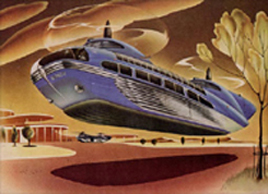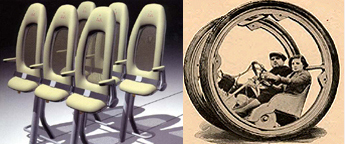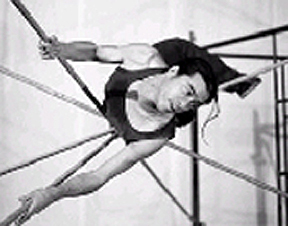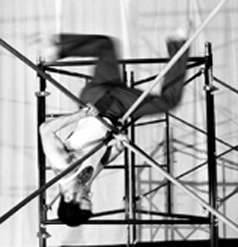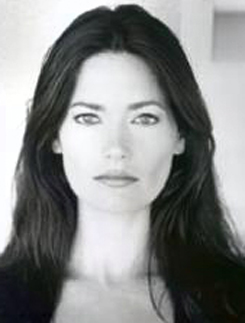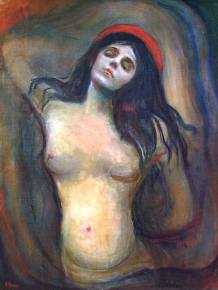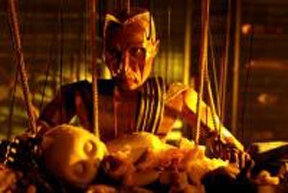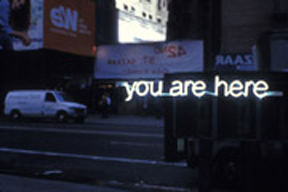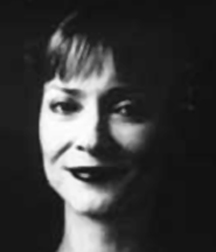
MUSIC/Disc series
"The Fine Art of Poisoning"
Jill Tracy, singer/songwriter/composer/storyteller
Got absinthe? Combining the intellectual eroticism of Baudelaire, and the cheerful ghoulishness of illustrator Ed Gorey, this singer/songwriter spins intoxicating tales of mayhem....
Inspiration never comes from any one thing specifically. It's more of a sensory response to the immediate; a word or phrase, an image, a story, a mood, a fragrance, textures and colors, the allure of the unknown, the forbidden, anything that enables me to "slip into the cracks," venture beyond what confines people to the Everyday.
It's a process of living to honor the magic, being alive in that place, allowing the flame. My purpose is finding those trapdoors, prying up the floorboards...
There's no rhyme or reason; that's the beauty of it, the sheer randomness. Sometimes a song will manifest itself in minutes, other times songs will remain in fragments in notebooks for years.
I've learned that you can't wait for inspiration; you have to earn it. You've got to work, be disciplined. Be true to your craft. Read great books. Immerse yourself in the discovery of new things. Live your art. The imagination has to be exercised, just like the body.
PASSION
People are born with a passion or an interest in varying degrees. For some, the vision is so singular and strong, there's no question that they are born to create music. They breathe it.
For others, perhaps family involvement, hobbies, or schooling has brought them to a conclusion that they want to pursue music as a job. There's a huge difference, obviously, between the two.
All songs begin with a seed of true life, be it from my own experiences, someone else's, or a longing thereof. That sordid past life we wish we were still living.
The difference? In real life, we won't be there to know how our story ends! That's the rub.
RANDOM FORTUNE
I'm a big believer in the fortune cookie philosophies. I tape those little white pieces of paper up everywhere. But I was taken aback when I stumbled across the quote: Just when everything seems to be falling apart, in the grand scheme it is merely falling into place.
Why do I remember that? Because it's absolutely true. It makes you realize that you don't know the magnitude of your own destiny. That phrase has helped keep me going through many a troubled time.
WORDS AND MUSIC
"Quintessentially Unreal" was a phrase that kept living in my head; the song came about from my attachment to the phrase and what it denotes.
The fact is that no matter how we perceive or pursue perfection, the quintessence of everything we aspire to, the reality will never be as good as the fantasy. Nothing ever will be. The ideal will always remain unreal.
I love that song; it's become an anthem for me, a song dedicated to dreamers. A song about not being afraid to admit that you long for something more. Resigning yourself to that fact. That what you really want can never exist.

"My music is a portal...I’m conjuring a mood, a magic place, getting out of this world for a little while. I love sharing that with my audience. It’s the grand escape."
"Into the Land of Phantoms" is the title of the album featuring my film score to F.W, Murnau's 1922 vampire classic, "Nosferatu."
There is that deliciously tense point in the film where the lead character is told to disembark the carriage. He is left alone to journey across a decrepit footbridge, a sinister landscape towering above him.
The carriage driver whispers: "We will go no further sir...into the land of phantoms."
In the context of a song, I’d say words and music have equal weight. The music will always evoke the initial response, luring the listener to travel further -- into the lyrics.
My music is a portal, a vehicle to transport the listener into another realm. When I write, I’m conjuring a mood, a magic place, getting out of this world for a little while. I love sharing that with my audience. It’s the grand escape.
INTO THE DARK
Happy isn’t really much of a stretch, is it? It’s easy and nice; it certainly isn’t perpetual or puzzling.
But the allure of mystery, the dangerous seduction -- that’s where the truth lives, under those protective layers of comfort and convention we hide behind.
The courage to peel away those layers and indulge in what lies underneath, to challenge ourselves -- that is far more compelling.
NECESSARY SILENCE
Quite frankly, music is not necessary in daily life. Sadly, these days, people use music as a distraction, background noise, as an excuse not to engage, to cop an attitude, to ignore the present.
We need to embrace the silent moments, tune into our surroundings and hear ourselves, our own thoughts.
I often focus on the constant plight of the free thinker, the struggle of being yourself in a world that is trying its hardest to turn you into everybody else.
Staying true to yourself; that’s the hardest and most glorious battle of all.
And aside from the allure of mystery and the forbidden, I also strive to give voice to the fact that it’s essential to be confident in your desires.
There is no need for a person to be afraid to be sensual, or to feel deep emotion, from rapture to agony. Those are all facets of the same diamond. You need all those facets to realize the full beauty of the gem.
CREATION
Writer’s block does rear its ugly head from time to time. After all, this is an intangible medium; you can’t schedule it and roll it out on an assembly line. The muse visits when she’s good and ready. Keeping things interesting, as a rule, tricks her into hanging around more.
The biggest myth about creative people? That a person who is “talented” has some magical power, that fabulous ideas pour out of them at all times, that they can turn it on or off like a switch, no effort whatsoever.
The truth is, just like any other skill set, a creative has to work hard and hone their craft. It’s a tedious job just like any other. The inner workings of it aren’t all that glamorous.
The most important thing a ‘creative’ needs, apart from paper and ink, is the thickest skin in the world and yet the most sensitive.
BAD INFLUENCE
Things that drive me crazy: Stupidity. People who are inconsiderate and clueless to everything around them. The fact that people continue to be brainwashed by the media, the mass marketing machine, politicians, and the manufactured cookie-cutter hype.
Especially now that the tactics these corporations use are so out in the open. I have a hard time believing that the world is still so gullible.
On the plus side, there are also people who are an inspiration, people who have left their mark in my life in some way.
The list is always growing and changing. Here are a few: Rod Serling, Ray Bradbury, The Cure, Steven Millhauser, Bernard Herrmann, Chrissie Hynde, Nina Simone, Beth Gibbons, Alfred Hitchcock, David Bowie, Roald Dahl, Pink Floyd, Fritz Lang, Alexander Scriabin.
IN PASSING...
While I lived in Manhattan, I developed this theory that angels would disguise themselves on earth in the form of cabdrivers. (Not all cabdrivers, mind you!)
They fulfilled their earthbound duties while carting fares. I had so many poignant, eye-opening, life-affirming revelations talking to New York City taxi drivers, it was unbelievable. Odd. And the beautiful thing was, I never saw them again.
Perhaps they returned to the heavens...or were stuck in the Bronx.

"I often focus on the constant plight of the free thinker, the struggle of being yourself in a world that is trying its hardest to turn you into everybody else.
Staying true to yourself; that’s the hardest and most glorious battle of all."
INSIDE TRACKS
From: "Pulling Your Insides Out"
Baby, mind the vultures
They’re circling round the bone
Feeding from the idols
They think they can draw blood from a stone
But the more the diamond glitters
The more it can deceive
The Truth lay in the treasure
Of what we disbelieve
“Pulling Your Insides Out” is a remark on the world and its feeding frenzy for mediocrity, that what glitters is false, fleeting and shallow...how everything that truly matters lies well beyond that phony world. But only for those who have the wherewithal to see it.
From: "Anything at All"
I’ll grant you the Nine of Cups
on eleven rainy days
I’ll pull apart the lion’s mouth
and I’ll make him sing your praise
I’ll challenge the great Houdini
to a remarkable escape
I’ll amputate the fingers
upon the Hand of Fate...
“Anything at All” attains that lovely storybook quality. It’s a collection of the most exquisite, preposterous things you could think of to show how much you want someone. How literally mad you are for them.
I love creating a classic timelessness in my songs. Perhaps you’ve stepped back in time, but simultaneously it couldn’t feel more relevant to that very moment.
From: "The Fine Art of Poisoning"
it’s quite an elaborate scheme
the fine art of poisoning
the dose to comatose
slyly administered
not for the frail of heart
the vengeful must play their part
a friend to the bitter end
or so they say
nice and slow
misfortune will flow
peril in the nursery
it seems a tainted pastry
one bite what a dreadful fright
she was such a delicate little dish
a pleasant parlor gathering
quicksilver concealed in a ruby ring
two lumps or three
i have always adored bergamot tea
nice and slow
misfortune will flow
but...who will know?
This song inspired the animated short film I later created with Bill Domonkos. I’m intrigued by the dark corners of history, a big source of inspiration for me.
I’d been studying various methods of poisoning through the ages, and wanted to bring that to life, but still keeping the covert, ambiguous and simple nature of poisoning itself. It sneaks up on you, never revealing itself -- until it’s too late.
Downtime:
I love reading, old movies, searching the second-hand bookshops for rare finds, as well as antique fairs for strange curiosities.
I like traveling, charting the course of the stars, talking to strangers, keeping ridiculously late hours, and swapping stories over cocktails.
What I’m reading right now:
"Oracle Night" (Paul Auster)
"The FeeJee Mermaid" (Jan Bondeson)
"Perfume"
(Patrick Suskind)
"Carter Beats the Devil" (Glen David Gold)
"Strange Brains and Genius : The Secret Lives Of Eccentric Scientists And Madmen" (Clifford Pickover)
"Victorian Murderesses" (Mary S. Hartman)
Favorite quote: From Albert Einstein: “The most beautiful experience we can have is the mysterious. It is the fundamental emotion which stands at the cradle of true art and true science. Whoever does not know it and can no longer wonder, no longer marvel, is as good as dead, and his eyes are dimmed.”
[Photo credits: Header image/Jon Bradford; Stairs image/Jim Ferreira.]
Artist bio: Singer/composer/storyteller Jill Tracy has been called a “femme fatale for the thinking man.”
She’s garnered multiple awards, and a devoted following, for her evocative music, glamorous style, and curious passion for collecting strange tales.
Jill Tracy coos in a voice of cut-velvet smoke, creating a world of opulence and danger, magic and madness. As one critic put it: “You know it’s not safe here; but with Jill Tracy as your guide, you’ll be in no hurry to leave.”
Aside from her stand-along CD trilogy (“Quintessentially Unreal,” “Diabolical Streak,” and "Into the Land of Phantoms") Jill Tracy appeared on the “Artists For Literacy” compilation CD alongside Tom Waits and Aimee Mann.
Her animated short film, “The Fine Art of Poisoning,” directed by Bill Domonkos, won over 20 national awards this year, meriting attention from artists like Clive Barker.
Tracy has performed everywhere from alternative rock venues and swanky cabarets. She’s been the opening act for American Cinematheque’s Film Noir Festival for the last two years.
Tracy is currently at work on two more film projects, penning songs for a new album, and developing works for the theatre. Short film “The Fine Art of Poisoning” was just selected for the Colorado Film Foundation’s Best Short Films of the Year DVD series.
Visit her official site here.
